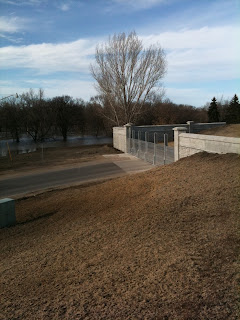 |
| rising Red River of the North, April 2013 |
In the spring of 1997, the Fargo-Moorhead area experienced what was described as a 500-year flood, based on the historical likelihood that a flood would only reach that height once in 500 years. The Red River of the North flooded to such a height that entire cities along its borders had to be evacuated. More than 50,000 people in Grand Forks, ND, East Grand Forks, MN and the area around them were evacuated as both cities we nearly completely inundated. In addition, a fire broke out downtown Grand Forks that destroyed eleven buildings and 60 apartment units.During that time, people all over the state of North Dakota and the northern half of Minnesota opened their homes to those who were evacuated.
TV crews from CNN, ABC, NBC, CBS, convened on Fargo and Moorhead and broadcast the events. One of my favorite radio stories about that event was an interview by a reporter from one of the big news outlets who asked a woman from one of those towns who sheltered evacuees why she was willing to invite strangers into her home. Her response, after a significant pause, "You're not from around here, are you?"
The cities of Grand Forks and East Grand Forks have been rebuilt since the flood. Flood control measures including construction of dikes to hold the waters within the river's banks are in place.
 |
river side of the dike on Rivershore Drive,
April 2013 |
Since 1997, there have been two more floods referred to as 100-year floods. In 2009, the home of my brother, Brian, and his wife, Lori, was in the path of the first of those 100-year floods. For three weeks, schools were closed, neighborhoods were cut off from the rest of the town, and my brother and his neighbors, with a lot of help from volunteers, placed sandbags around their homes, barricading them on an island formed by the sandbags. They moved everything from their basement to the main floor - beds, sofas, washing machine and dryer, clothes from closets, boxes, bookshelves and books.
My brother and his family had lived in their house since 2004, but they hadn't met many of their neighbors. As the river threatened to rise, one of those neighbors, one who had just recently moved into the neighborhood, came to the door to ask Brian to join him and the neighbors who lived between them to sandbag the houses as one island instead of placing separate barriers around each house. Brian didn't immediately agree to help out, leaving the neighbors uncertain that they had convinced him. The next morning, however, they found Brian outside already beginning the wall of sandbags to separate their homes from the river. For two weeks, until the river crested, they worked in shifts to make sure that the pumps in place to remove any water that broke through the sandbags was pumped back over the wall and back into the river. For another week, their homes were cut off from the rest of the city until the city removed the sandbags and the temporary dirt and clay dike down the center of the street.
Brian taped the words
Thank you backwards on the windows of his living room to let all those who helped know how they felt.
 |
| Red River above flood stage, April 2013 |
The following year, 2010, a second 100-year flood struck along the Red River. This time, the city of Moorhead began early enough to erect dirt and clay dikes along the edge of the river so that my brother and his neighbors did not have to sandbag their homes. That October, my brother passed away seven weeks after having been diagnosed with acute myeloid leukemia. After his funeral, many of us gathered at his house where we continued to reminisce with my brother's friends out on the driveway and yard where those sandbags were placed in April and May the year before. At the end of that day, my beautiful sister-in-law and my brother's wife Lori gave several of us a hug and said a most remarkable thing: Thank God for the flood. She knew that she wouldn't have gotten to know the neighbors without it.
 |
Street side of the dike on Rivershore Drive,
April 2013 |
Following the 2010 flood, Moorhead bought out the houses closest to the river and erected a permanent dike to protect the rest of the city. My brother's neighbors across the street were among those who sold their homes and moved. The remaining neighbors have continued to provide Lori help with broken garage door openers and other maintenance challenges.
This year, the river crest is predicted for Thursday, May 2, at 37 feet. The gates at the dike at the end of the street where Lori's house is were closed this morning, providing protection up to 42 feet. Even the neighbor across the street who chose not to sell his home is doing nothing to protect his home this year as his house is safe so long as the river does not exceed 40 feet.
Floods and silver linings. Remarkable people.




No comments:
Post a Comment